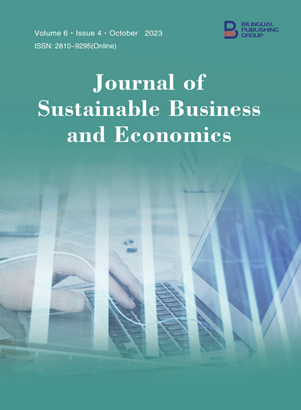-
307
-
192
-
190
-
182
-
152
Strategy, Ownership, and Performance of Firms in India: A Study of Manufacturing and Service Industries in India
DOI:
https://doi.org/10.30564/jsbe.v7i1.5879Abstract
Purpose: There is considerable interest among academicians as well as practitioners in strategic differences between foreign-owned firms and domestic businesses. Linked with this is the question of whether there is a relationship between strategy and performance. This paper primarily concentrates on the differences in strategy pursued by foreign-owned firms and domestic firms. Methodology: A questionnaire was constructed. It was administered to senior level managers of reputable firms. The comprehensive list of managers was obtained from various databases including that of the Confederation of Indian Industry (CII). Responses to the questionnaire were received in two phases. The questionnaire was sent again after a fortnight of sending it the first time. None of the respondents asked for any clarification during their responses to the questionnaire. Findings: Results of analysis of the responses obtained clearly showed the differences in strategy between the two sets of firms. In the overall perspective, foreign-owned firms are much more holistic in their approach, whereas the domestic firms are quite narrow in their outlook—the domestic firms primarily concentrate on resources and how to add customers in order to survive and grow. The concept of investing in R & D, which is a prime parameter of strategy for foreign-owned firms, is completely absent in the case of domestic firms. As a result, factors affecting performance are far more widespread for foreign-owned firms than it is for domestic firms. Originality: While the comparison has been made between FOB and DOB, the differences in strategy have never been investigated before.
Keywords:
Strategy; Marketing; Performance; foreign-owned business; Domestic businessReferences
[1] Krishnan, Chitra; Globalization and its impact on business environment, IndianMBA.com, July 2009.
[2] Cravens, D.W., 2000. Strategic marketing, 6th ed. McGraw-Hill: Boston.
[3] Cravens, D.W., Merrilees, W.J., Walker, R.H., 1999. Strategic marketing management for the Pacific region. McGraw-Hill Higher Education: Sydney.
[4] Bettis, R.A., Hitt, M.A., 1995. The new competitive landscape. Strategic Management Journal. 16(S1), 7–19. DOI: https://doi.org/10.1002/smj.4250160915
[5] Miah, N.Z., Mia, L., 1996. Decentralization, accounting controls and performance of government organizations: A New Zealand empirical study. Financial Accountability & Management. 12(3), 173–190. DOI: https://doi.org/10.1111/j.1468-0408.1996.tb00421.x
[6] Hooley, G., Broderick, A., Möller, K., 1998. Competitive positioning and the resource-based view of the firm. Journal of Strategic Marketing. 6(2), 97–116. DOI: https://doi.org/10.1080/09652549800000003
[7] Matsuno, K., Mentzer, J.T., Özsomer, A., 2002. The effects of entrepreneurial proclivity and market orientation on business performance. Journal of Marketing. 66(3), 18–32. DOI: https://doi.org/10.1509/jmkg.66.3.18.18507
[8] Srivastava, R.K., Shervani, T.A., Fahey, L., 1998. Market-based assets and shareholder value: A framework for analysis. Journal of Marketing. 62(1), 2–18. DOI: https://doi.org/10.1177/002224299806200102
[9] Bonoma, T.V., Crittenden, V.L., 1988. Managing marketing implementation. MIT Sloan Management Review. 29(2), 7.
[10] Li, L., McMurray, A., Sy, M., et al., 2018. Corporate ownership, efficiency and performance under state capitalism: Evidence from China. Journal of Policy Modeling. 40(4), 747–766. DOI: https://doi.org/10.1016/j.jpolmod.2018.03.002
[11] Singla, C., George, R., Veliyath, R., 2017. Ownership structure and internationalization of Indian firms. Journal of Business Research. 81, 130–143. DOI: https://doi.org/10.1016/j.jbusres.2017.08.016
[12] Strange, R., 2018. Corporate ownership and the theory of the multinational enterprise. International Business Review. 27(6), 1229–1237. DOI: https://doi.org/10.1016/j.ibusrev.2018.05.004
[13] Abramov, A., Radygin, A., Entov, R., et al., 2017. State ownership and efficiency characteristics. Russian Journal of Economics. 3(2), 129–157. DOI: https://doi.org/10.1016/j.ruje.2017.06.002
[14] Song, J., Wei, Y.S., Wang, R., 2015. Market orientation and innovation performance: The moderating roles of firm ownership structures. International Journal of Research in Marketing. 32(3), 319–331. DOI: https://doi.org/10.1016/j.ijresmar.2015.03.005
[15] Foster-McGregor, N., Kaulich, F., Stehrer, R., 2015. Global value chains in Africa. UNU-MERIT Working Paper Series Vol. 2015-024.
[16] Sukhtankar, S., 2016. Does firm ownership structure matter? Evidence from sugar mills in India. Journal of Development Economics. 122, 46–62. DOI: https://doi.org/10.1016/j.jdeveco.2016.04.002
Downloads
How to Cite
Issue
Article Type
License
Copyright © 2024 Rahul Gupta Choudhury

This is an open access article under the Creative Commons Attribution 4.0 International License.




 Rahul Gupta Choudhury
Rahul Gupta Choudhury


